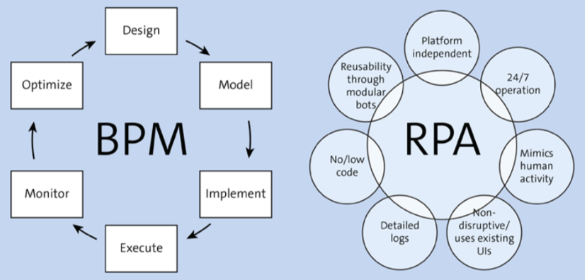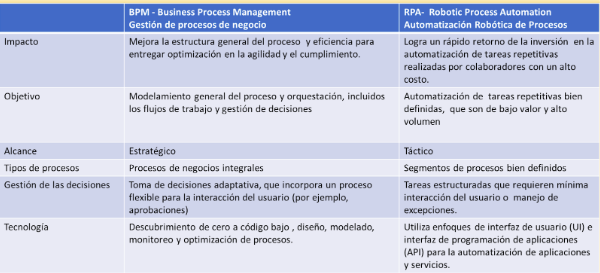RPA: Automating repetitive company processes.
Last updated : March 22, 2023Did you like our article?
RPA: Automating repetitive company processes.
Robotic Process Automation (RPA) is an emerging technology that has revolutionized the way companies perform their repetitive processes. Companies use various systems to support their administrative processes, some with very manual tasks that require considerable time and effort to execute; in turn, each of these systems have different architectures, have integrations with different languages and protocols, which at the end of the day, trying to automate certain processes, is complex to execute and manage.
The implementation of RPA can help automate repetitive processes, not only limited to a single system, as in the case of accounts payable or those processes that have data entries from different sources. It also makes it possible to collect information from purchase orders and consolidate it manually in an excel file to make visible, channel and unite applications that are not integrated in a process, such as a repetitive check and sending emails with all the information of attached documents under a certain format. In addition, it allows downloading and categorizing reports to share in drive via email and data correction in certain transactional processes; in short, there is a series of benefits where repetitive tasks can be related to clear and defined rules specific to the business.
At Novis, we have always thought that technologies must be used according to the requirements of the business and therefore, we carry out limited iRPA projects, of short scope and high impact, such as: self-management of unblockings, creation of masters, automation of sending information to certain collaborators according to certain rules or actions, among others, but always maintaining the premise of starting with very specific repetitive tasks and from there jumping to a more elaborate process.
Now, before implementing an RPA you need to ask yourself some key questions:
- Do you have tasks in your processes that are complicated and that you sense can be automated?
- Do you have a significant opportunity cost for a particular employee? That is, does he/she give more value to the company when he/she uses his/her man-hours on management or other similar tasks?
- Do you have a process that requires governance and compliance that merits automation?
It is very important before starting an RPA project, to have an outline or a process diagram with any BPM that one wants to automate, since RPA not only comes to automate tasks, but also processes and hence the importance of mapping well the tasks of my organization.
In general, smart companies are those that at the end of the day spend a lot of time analyzing the information or the result of their processes, with discrete data and make business decisions based on the information. In this scenario, many times management reports or dashboards are not intuitive, they require an analysis where the middle management resource is the one who has a lot to say and that is where the real benefit of RPA lies, I leave my resource to analyze and not to do repetitive or “boring” tasks.

Diagram 1: SAP Press e-bites: Introducing SAP Intelligent robotic process automation.

Diagram 2: SAP Press e-bites: Introducing SAP Intelligent robotic process automation.
SAP has its own RPA and it is called iRPA (Intelligent Robotic Process Automation), this product has iRPA Cloud Studio in BTP as its main component, which is where it is developed with an important library of functionalities and allows monitoring what is done, there is another functionality that is an agent that is installed on the user’s desktop to generate the automation scripts and finally, a development environment that allows creating the automations and that is also installed on the user’s desktop.
Some of the benefits of these automation tools include:
• Financial Impacts
– Reduction of labor costs.
– Reduction of the execution costs of the whole process.
– No physical workspace required.
– Reduced risk exposure due to human error.
– Reduced paper usage.
• Organizational Impacts
– Increased employee morale by making them focus on higher value tasks and not on tedious tasks with no value.
– Process mapping that is useful for governance solutions and provides a basis for easy audits by company control areas.
– Detailed operation records for transparency and traceability, we have a monitoring with the log of the executions performed.
• Operational Impacts
– Improved operational quality through consistent execution.
– Reduced process execution time, resulting in improved overall performance.
– Reduction of errors and the double work associated with their correction.
– Operates 24 hours a day, 7 days a week from any location.
– Scales up or down quickly with changing conditions, such as peak transaction periods or seasonal demand.
– Minimizes impact on existing systems with load balancing, as tasks are executed or scheduled at “no peak” times.
Contact us so that we can present this solution and the benefits it could bring to your company.
Feedback/discussion with the author: Luis Sasmay, Functional Solutions Architect at Novis.


